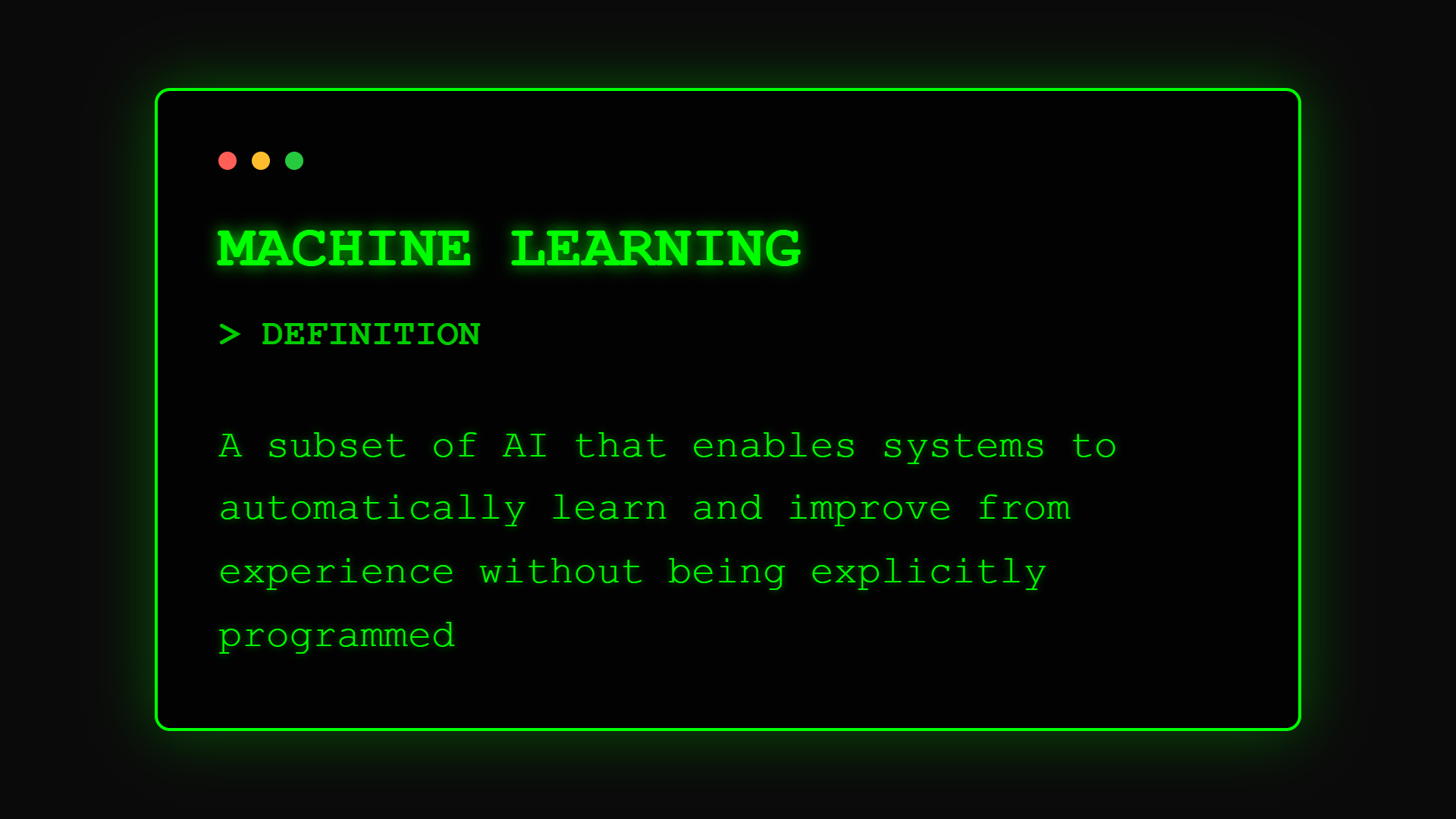AI Terms
What is Machine Learning? Teaching Computers to Learn Like Humans

Netflix knows what you'll watch next. Your bank catches fraud before you notice. Amazon ships products before you order them. How? They're using machine learning: technology that gets smarter with every interaction, learning from experience just like humans do, but at massive scale.
Historical Context and Definition
Machine learning emerged from pattern recognition research in the 1950s, with Arthur Samuel coining the term in 1959 as "the field of study that gives computers the ability to learn without being explicitly programmed."
The formal computer science definition, according to Tom Mitchell (1997), states: "A computer program is said to learn from experience E with respect to some class of tasks T and performance measure P, if its performance at tasks in T, as measured by P, improves with experience E."
Initially limited by computing power, ML remained largely theoretical until the 2000s. The explosion of data, cloud computing, and algorithmic breakthroughs transformed it from academic curiosity to business necessity.
The Business Perspective
For business leaders, machine learning means systems that automatically improve their performance through experience, getting better at predicting, deciding, and optimizing without manual updates.
Think of ML as hiring an analyst who never forgets a pattern, works 24/7, and can simultaneously analyze millions of scenarios. Unlike traditional software with fixed rules, ML systems write their own rules based on data patterns.
In practical terms, this means your fraud detection gets better with each transaction, your demand forecasting improves with each sale, and your customer service becomes more personalized with each interaction.
Key Elements
Machine learning consists of these essential elements:
• Training Data: Historical examples that teach the system patterns, like showing thousands of fraudulent and legitimate transactions to teach fraud detection
• Algorithms: Mathematical recipes that extract patterns from data: decision trees for classification, neural networks for complex patterns, regression for predictions
• Model: The learned representation of patterns, essentially the "brain" created from training that can make predictions on new data
• Features: The specific data points the model considers. For credit scoring, features might include income, payment history, and debt ratio
• Evaluation Metrics: Measurements of model performance like accuracy, precision, and recall that determine if the system is learning effectively
The Learning Process
The machine learning process follows these steps:
Data Collection & Preparation: Gather historical data, clean inconsistencies, and format for analysis, like collecting years of sales data with weather, promotions, and seasonal factors
Training & Pattern Recognition: The algorithm analyzes data to find patterns, creating a mathematical model that captures relationships, discovering that ice cream sales correlate with temperature but spike during local events
Testing & Deployment: Validate the model on new data it hasn't seen, then deploy to make real-world predictions, using the model to forecast tomorrow's ice cream demand and optimize inventory
The key difference from traditional programming: you don't tell the system HOW to identify patterns; you show it examples and let it figure out the rules.
Three Main Approaches
Machine learning generally falls into three main categories:
Type 1: Supervised Learning Best for: Prediction, classification, fraud detection Key feature: Learns from labeled examples (input-output pairs) Example: Email spam filters trained on messages marked "spam" or "not spam"
Type 2: Unsupervised Learning Best for: Customer segmentation, anomaly detection, pattern discovery Key feature: Finds hidden patterns without labels Example: Grouping customers by behavior without predefined categories
Type 3: Reinforcement Learning Best for: Optimization, game playing, robotics Key feature: Learns through trial and error with rewards Example: Delivery route optimization that improves through feedback
Success Stories
Here's how businesses actually use machine learning:
E-commerce Example: Amazon's recommendation engine drives 35% of revenue by analyzing purchase patterns across 300 million customers, generating personalized suggestions in real-time.
Financial Services Example: PayPal reduced fraud losses by 50% using ML models that analyze 1,000+ variables per transaction, learning new fraud patterns as they emerge.
Manufacturing Example: General Electric uses ML for predictive maintenance, analyzing sensor data to predict equipment failures 35 days in advance, reducing downtime by 20%.
Continue Your Journey
Ready to leverage machine learning in your business?
- Understand the foundation with Artificial Intelligence concepts
- Explore specific techniques like Deep Learning for complex patterns
- Learn about Supervised Learning for prediction tasks
- Implement with our ML Implementation Playbook
FAQ Section
Frequently Asked Questions about Machine Learning
Part of the [AI Terms Collection]. Last updated: 2025-01-11